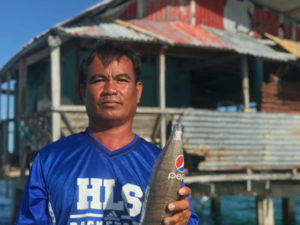
Philippine fisherman Jocel Cabansay uses a bottle of sand to show how illegal fishing makes use of dynamite to catch fish.
SOURCE CHRISTOPH SATOR/GETTY
When there’s an underwater explosion, “it feels like the entire ocean collapses on you,” longtime diver and environmentalist Terence Lim says. Diving in Malaysia’s waters for 25 years, he has felt the pressure waves from fishermen’s homemade bombs and seen how explosions turn once vibrant reefs into rubble. Though outlawed, this explosive fishing method is common in Southeast Asia and along the Tanzanian coast due to its extreme efficiency.
Now, after decades of largely futile attempts to crack down on blast fishing, environmentalists and marine scientists are turning to what they believe could prove the missing link in their efforts: acoustic data. In Malaysia’s Sabah province, Lim and his fellow members of the Hong Kong-registered NGO Stop Fish Bombing have devised a way to record blasts up to 12 miles away. By placing hydrophones 2 to 8 meters underwater, attached to a boat or a pier, they record the blasts and through triangulation — cross-verification of data — they can pinpoint their location.
Across the Indian Ocean, in Tanzania, a collective of local nonprofits called the Tanzania Blast-fishing Monitoring Network (TBMN) has since 2014 been training fishermen to record blasts from the shore. Scattered along a 500-mile coastline, 24 monitors record blasts and later, their data is analyzed and shared with government officials. Also in Tanzania, marine scientist Gill Braulik has installed acoustic recorders on the seabed on five sites along the coast, with funding support from the data journalism initiative Code for Africa. The hydrophones can pick up blasts from 19 miles away.
WE ARE KEEPING A WATCHDOG’S EYE ON WHAT IS GOING ON.
ATTRIBUTION HERE
Data from these initiatives, especially in Tanzania, played an important part in supporting government efforts to set up a task force to target blast fishing in 2015, says fisheries specialist Jason Rubens, who has been tracking blast fishing in Tanzania for a decade. And blasts have reduced dramatically since then. According to data from the TBMN based on their monitors, blasts off the coastal town Tanga dropped from an estimated 1,773 in August 2016 to 409 in August 2017, and only 40 in August 2018. And when Braulik analyzed her acoustic data from early 2019, it showed only five to six weekly blasts near Tanga.
“We are keeping a watchdog’s eye on what is going on,” Braulik says. “This is the only way you can find out what is happening in the huge ocean.”
It’s easy to see the appeal of blast fishing. Within seconds, the blast ruptures organs of schools of fish, leaving them gasping at the surface or plummeting to the bottom. But the easy catch comes with a steep price; future fishing grounds are destroyed, diving tourism dwindles, fishermen are injured and, in the worst cases, it can prove deadly. In July, two Chinese divers and their divemaster died in the waters off Sabah, allegedly after fish bombs were detonated nearby.
The detection system Lim and his team have developed could prove a “game changer” in tracking blast fishing, he says. “Blast fishing has been occurring for many years, but we haven’t had the tool to locate it,” Lim says.
To develop the acoustic technology, Stop Fish Bombing teamed up with ShotSpotter, a California-based company that uses sensors to detect gunshots in American cities, and in 2015, they successfully recorded their first blasts off Sabah. Still, it is only this year that they received funding to deploy more sensors and set up a system that notifies enforcers directly.
“The ocean is huge and we can’t expect authorities to be there at all times, so this is like installing CCTVs underwater,” Lim says eagerly, adding that the team will travel to the Philippines to share their method with the conservation organization Oceana.
Over in Tanzania, Braulik discovered the scale of blast fishing by coincidence. Back in 2014, she sailed along the coast to record sounds of whales and dolphins, when inadvertently, her hydrophones picked up the sound of explosions underwater. Near the commercial capital Dar es Salaam, the acoustic data showed up to 11 blasts per hour. While she expected to pick up a few blasts, she had not expected this. Braulik kept recording the blasts and last year, she went deep into the ocean to continue her recordings undisturbed.
The data she and the TBMN are collecting is critical for authorities to understand the scale of the challenge they face and where they need to focus their attention, suggests Rubens. “If you can’t quantify the problem in time and space, then it is difficult for authorities to respond to blast fishing,” he says.
Still, the success of data as a tool to eradicate blast fishing relies heavily on political will and the capacity for enforcement responses, Rubens emphasizes. He calls Stop Fish Bombing’s approach in Malaysia “laudable but also very ambitious,” pointing out that real-time transmission of data to authorities requires a huge effort to secure the acoustic equipment in the ocean and an extremely well-organized enforcement response.
“For that reason, it is not feasible to do real-time transmissions in Tanzania, and it probably would be difficult to maintain over time even in some European countries,” he says. Even with a two-three month time-lag from when it was first captured, the data remains relevant and important, he adds.
Lim acknowledges that it won’t be easy for local enforcers in Sabah to respond to real-time notifications. However, “once there is hard, solid data, we can push for action,” he says. Meanwhile, he hopes to wean fisherfolk away from blast fishing by training them in carpentry and fish farming.
That might well prove as critical as tracking blast fishing or capturing data in getting fishermen to quit the practice. At Dar es Salaam’s main fish market, fishermen and customers haggle over snappers and tuna. A fisherman, who requests anonymity, admits having used explosives in the past although he would rather not endanger his life. “When life is tough, what should you do?” he asks.
Source Link: Ozy





